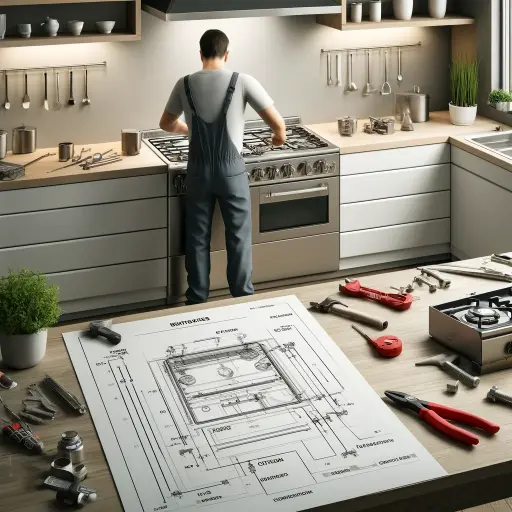Installing a gas stove involves careful planning and adherence to safety protocols to ensure efficient and secure operation. This step-by-step guide to gas stove installation outlines the entire process of installing a gas stove, from preparation to final checks.

Proper installation is crucial for the safe and effective use of a gas stove. Whether you’re replacing an old stove or installing a brand-new one, following these detailed steps will help you set up your appliance correctly.
Guide to Gas Stove Installation – 5 Easy Steps
Step 1: Preparation
a. Tools and Materials
Gather all necessary tools and materials before starting the installation. This typically includes:
- Wrenches
- Screwdrivers
- Gas hose
- Teflon tape
- Leak detection solution or soapy water
b. Choose the Right Location
Select an appropriate location for your stove. It should be near a gas supply line and have good ventilation. Ensure it is away from flammable materials and has enough clearance as specified in the stove’s manual.
c. Measurements
Measure the space to ensure the stove will fit. Consider both the dimensions of the stove and the necessary space around it for heat dissipation and safety.
Step 2: Remove Old Stove (If Applicable)
a. Shut Off Gas
Before removing an old stove, ensure the gas supply is completely shut off.
b. Disconnect Gas Line
Using a wrench, carefully disconnect the gas line from the old stove. Be prepared for some residual gas to escape when you disconnect the line.
c. Remove the Stove
Once disconnected, safely remove the old stove from its position. This may require assistance due to the weight of the stove.
Step 3: Install the New Stove
a. Position the Stove
Carefully move the new stove into its designated location. Avoid damaging the gas connection and control knobs.
b. Connect Gas Line
Connect the gas hose to the stove using Teflon tape on the threads to ensure a secure fit and prevent leaks. Attach the other end of the hose to the gas supply line. Make sure all connections are tight and secure.
c. Check for Leaks
Apply a leak detection solution or soapy water along the gas line connections. Turn on the gas supply slightly and watch for bubbles, which indicate a leak. Tighten any fittings as necessary to eliminate leaks.
Step 4: Test the Stove
a. Light Burners
Test each burner by turning them on individually to ensure they ignite correctly and the flame is even and stable.
b. Adjust Flame Settings
If necessary, adjust the flame settings according to the manufacturer’s instructions to ensure optimal performance.
c. Inspect Installation
Double-check all aspects of the installation to ensure everything is secure, especially the gas line connections and stove positioning.
Step 5: Final Setup
a. Install Ventilation (if needed)
If your stove requires external ventilation, install an appropriate vent hood above the stove. Ensure it is properly connected and functioning.
b. Clean Up
After installation, clean up any debris or tools from the area. Ensure the stove surface is clean and clear of any materials used during the installation process.
c. Safety Check
Conduct a final safety check to ensure the stove is stable, the area around it is clear of any flammable materials, and the ventilation is adequate.
How to Install a Gas Stove: Whirlpool Stainless Front Control Gas Range
Conclusion
Installing a gas stove is a critical task that requires precision and adherence to safety standards. By following the steps enumerated in this guide to gas stove installation, you can ensure your stove is set up correctly and ready for safe use.
Always refer to the specific instructions provided by your stove’s manufacturer and consider hiring a professional if you are unsure about any steps. Proper installation will not only provide a safer cooking environment but also enhance the efficiency and longevity of your stove. Remember, safety is paramount when dealing with gas appliances.
